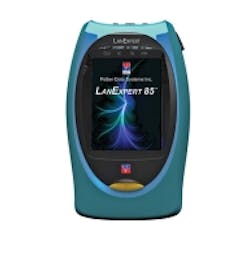Test networks from physical layer to protocol analysis
The tester uses an SFP-based platform, and with different modules can test singlemode- or multimode-fiber as well as twisted-pair copper connections. Also, the LanExpert 85 has the capability to conduct tests in inline mode, which the company’s president Darrell Johnson says is a powerful capability that monitors actual data between network devices, thereby allowing the user to identify and correct problems that otherwise would be difficult to find. The tool is appropriate and useful in enterprise and service-provider networks, the company notes.
In addition to checking cabling, the tester can verify connectivity across a network, capture packets and analyze them, measure bandwidth capacity and identify switches that are either failing or incorrectly configured. According to Psiber, this many-testers-in-one piece of equipment can replace tools including length meters, fault locators, protocol analyzers, traffic generators and stress-test equipment among others.
From a data sheet for the LanExpert 85, here is a list of the product’s capabilities.
- Link detection
- Ping-and-trace route to verify network connectivity
- Single-ended or inline packet monitoring
- Filtering and capture to identify and solve problems
- User-defined traffic generation and structured RFC 2544 stress test to predict network performance under various load conditions
- Loopback, VoIP and email tests to ensure performance of network services
Starting price for the LanExpert 85 is $2,495.
Signs point to copper prices staying high
Economic reports from the week of May 23-27 indicate the cabling industry, along with many other construction trades, likely will be dealing with high copper prices for the long term.
On May 25 Bloomberg reported that Chile’s president Sebastian Pinera said the metal’s price won’t come down much even if economic growth cools down in China. Chile is the world’s largest producer of copper; the country owns and operates the copper company Codelco.
Bloomberg’s reporting said that according to Chile’s central bank, the price of copper likely will be about $4.20 per pound throughout 2011. The average price in 2010 was $3.42, Bloomberg reported.
Fluke Networks introduces patch-cord test adapter
In technical information about its new patch-cord test adapters, Fluke Networks says that despite claims of standard compliance printed on the jackets of patch cords, most of those cords are tested only for wire map.
The DTX Patch Cord Test Adapter series from Fluke Networks can certify twisted-pair patch cords, shielded or unshielded, to Category 5e, 6 and 6A component specifications established in TIA-568-C and ISO 11801 standards. Fluke says a Cat 6 autotest takes just 6 seconds, and the adapters are appropriate in both enterprise and manufacturing environments.
With the adapters, a user can test patch-cord parameters including wire map, length, propagation delay, delay skew, near-end crosstalk, resistance and return loss.
In a data sheet for the patch-cord test-adapter series, Fluke Networks notes, “Most cords are only tested for wire map, not performance - in spite of what may be indicated on the jacket. Channel certification shows the performance of the completed end-to-end link including equipment and work area patch cords. Permanent link certification shows the true performance of the installed link without the cords. This is very common because it’s the most practical and accurate way to certify new cabling links, but it is dependent on compliant patch cords. Patch cord certification can quickly determine whether a patch cord meets industry performance specifications. When non-compliant cords are used, they can cause intermittent failures that can result in network downtime and warranty claims.” Data sheets can be downloaded from flukenetworks.com.
Cat 6A cable for outside-plant use
Superior Essex has announced the immediate availability of its Category 6A Outside Plant (OSP) Broadband cables, which enable the expansion of 10 Gigabit Ethernet networks to outdoor environments using copper cable. The company says the new cables may be deployed in areas in which the NEC requires use of an OSP-rated cable when in contact with earth, regardless of whether it is in a conduit or not.
The company says its BBDN6A and BBDG6A CAT6A OSP-rated cables consist of four balanced twisted pairs surrounded by PFM gel which not only prevents water ingress, but will not drip or flow, even in cell tower applications. The BBDN6A cable includes an 0.008” thick aluminum shield and the BBDG6A includes a corrugated copper-clad steel armor for alien-crosstalk performance.
